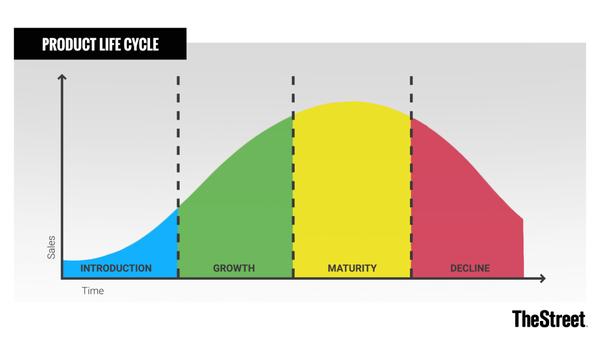Historicalevolution
1.Theproductlifecycledefinedbymarketingis:introduction,growth,maturity,anddecline.Thiscannolongersummarizetheentireprocessoftheproductlifecycle.Justlikethelifecycleofapersonwillneverbetheprocessfrombirthtodeath.Wedefinethesefourstagesas:productmarketlifecycle.
2.WiththeriseofPLMsoftware,theproductlifecyclebeginstoincluderequirementscollection,conceptdetermination,productdesign,productlaunchandproductmarketlifecyclemanagement.Justlikethehumanlifecycle,theparent’spreparationandpregnancyprocessandtheprocessofchildbirthalsodefinethehumanlifecycle.
3.Manyexcellentcompaniesinmoderntimesfeelthattheabovetwolifecyclescannotfullysummarizetheproductlifecycle.Basedontheconceptofproductmanagement,theproductlifecycleissummarizedas:productstrategy,productmarket,productdemand,productplanning,productdevelopment,productlaunch,productdelistinglifecyclemanagement7parts.
Principle
(1)Productlifecyclestages
Atypicalproductlifecyclecangenerallybedividedintofourstages,namelyEntryperiod,growthperiod,saturationperiodanddeclineperiod
1.Entryperiod.Whenanewproductisputonthemarket,itenterstheinvestmentperiod.Atthistime,customersstilldon’tunderstandtheproduct,andonlyafewcustomerspursuingnoveltymaybuyit,andthesalesvolumeisverylow.Inordertoexpandsales,alotofpromotionalexpensesarerequiredtopromotetheproducts.Atthisstage,duetotechnicalreasons,theproductscannotbeproducedinlargequantities,sothecostishigh,andthesalesgrowthisslow.Notonlycanthecompanynotgetprofits,butitmaylosemoney.Theproductalsoneedstobefurtherimproved.
2.Growthperiod.Atthistime,customersarealreadyfamiliarwiththeproduct,alargenumberofnewcustomersstarttobuy,andthemarketisgraduallyexpanding.Theproductsaremass-produced,theproductioncostisrelativelyreduced,thecompany'ssalesarerisingrapidly,andtheprofitsarealsogrowingrapidly.Competitorsseeprofitabilityandwillenterthemarketoneafteranothertoparticipateinthecompetition,sothatthesupplyofsimilarproductswillincrease,andthepricewilldecreaseaccordingly.Thegrowthrateofcorporateprofitswillgraduallyslowdown,andfinallythehighestpointoflifecycleprofitwillbereached.
3.Saturationperiod.Themarketdemandtendstobesaturated,therearefewpotentialcustomers,andthesalesincreaseslowlyuntilitturnsdown,whichindicatesthattheproducthasenteredamatureperiod.Atthisstage,competitionhasgraduallyintensified,productpriceshavefallen,promotionalexpenseshaveincreased,andcorporateprofitshavefallen.
4.Declineperiod.Withthedevelopmentofscienceandtechnology,theappearanceofnewproductsornewsubstituteswillchangetheconsumer'sconsumptionhabitsandswitchtootherproducts,whichwillcausethesalesandprofitsoftheoriginalproductstodeclinerapidly.Asaresult,theproducthasenteredaperiodofdecline.
(2)Productcategory,form,andbrandlifecycle
Productcategoryreferstoallproductswiththesamefunctionandpurpose.Productformreferstodifferentproductsofthesamecategorythathavedifferentauxiliaryfunctions,uses,orphysicalsales.Theproductbrandreferstoaspecificproductproducedandsoldbyanenterprise.Forexample,Baishabrandfiltercigarettes,cigarettesindicatetheproductcategory;filtercigarettesareatypeofcigarette,thatis,productform;Baishabrandfiltercigarettesspecificallyrefertoaspecificproductandaproductbrandinfiltercigarettes.Thelifecycleofaproductcategoryislongerthantheproductformandproductbrand,andthematurityperiodinthelifecycleofsomeproductcategoriesmaycontinueindefinitely.Theproductformgenerallyshowstheabove-mentionedtypicallifecycleprocess,thatis,startingfromtheintroductionperiod,passingthroughthegrowthperiod,thematurityperiod,andfinallythedeclineperiod.Asforthelifecycleofbrandedproducts,itisgenerallyirregular,anditisaffectedbythemarketenvironment,corporatemarketingdecisions,andbrandawareness.Abrandwithahighreputationhasalonglifecycle,andviceversa.Forexample,internationallyrenownedbrandslike"Coca-Cola"haveremainedsopopularforahundredyears.
Briefdescriptionofthecycle
Theconceptofproductlifecycle(productlifecycle),referredtoasPLC,istocomparethesaleshistoryofaproducttothelifecycleofaperson.Stagesofgrowth,maturity,aging,anddeath.Asfarastheproductisconcerned,itmeansgoingthroughastageofdevelopment,introduction,growth,maturity,anddecline.
(1)Productdevelopmentperiod
Theperiodfromtheideaofdevelopingtheproducttothesuccessfulmanufacturingoftheproduct.Duringthisperiod,thesalesoftheproductwaszero,andthecompany'sinvestmentcontinuedtoincrease.
(2)Introducingperiod
Newproductsarenewlylaunchedandsalesareslow.Becausethecostofintroducingproductsistoohigh,theinitialprofitisusuallylowornegative,butatthistimetherearenoorveryfewcompetitors.
(3)Growthperiod
Afteraperiodoftime,theproducthasbecomequitewell-known,withrapidsalesgrowthandasignificantincreaseinprofits.However,duetotherapidgrowthofthemarketandprofits,itiseasytoattractmorecompetitors.
(4)Maturityperiod
Atthistime,themarketgrowthtrendisslowingdownorsaturated,theproducthasbeenacceptedbymostpotentialbuyers,andprofitsgraduallydeclineafterreachingthepeak.Atthistime,themarketisfiercelycompetitive,andthecompanyneedstoinvestalotofmarketingexpensesinordertomaintainitsproductposition.
(5)Recessionperiod
Duringthisperiod,productsalesdeclinedsignificantly,andprofitsfellsharply.Withthesurvivalofthefittest,therearemoreandmoremarketcompetitors.
Cyclecurve
Characteristicsofthelifecyclecurve:Duringtheproductdevelopmentperiod,theproductsalesarezero,andthecompany'sinvestmentcontinuestoincrease;duringtheintroductionperiod,salesareslow,andinitialprofitsareusuallylowOranegativenumber;duringthegrowthperiod,salesincreaserapidly,andprofitsalsoincreasesignificantly;duringthematureperiod,profitsgraduallydeclineafterreachingthepeak;duringtherecessionperiod,productsalesdeclinesignificantly,andprofitsalsodropsignificantly.
Scopeofapplication:Thecurveissuitableforthedescriptionofthelifecycleofgeneralproducts;itisnotsuitableforthedescriptionofthelifecycleofstyle,fashion,hotandscallopproducts.
Marketingstrategy
Thefourstagesofatypicalproductlifecyclepresentdifferentmarketcharacteristics,andthecompany’smarketingstrategyisformulatedandimplementedbasedonthecharacteristicsofeachstage.
Marketingstrategyduringtheintroductionperiod
Thecharacteristicsoftheintroductionperiodarelowproductsales,highpromotionexpenses,highmanufacturingcosts,andloworevennegativesalesprofits.Accordingtothecharacteristicsofthisstage,companiesshouldstrivetoachieve:theproductsputintothemarketshouldbetargeted;thetimeofenteringthemarketshouldbeappropriate;trytodirectsalesforcetothemostlikelybuyers,sothatthemarketcanaccepttheproductassoonaspossible.Shortentheintroductionperiodandenterthegrowthperiodfaster.
Duringtheproductintroductionperiod,thefourbasicelementsofproduct,distribution,price,andpromotioncangenerallybecombinedintoavarietyofdifferentmarketingstrategies.Consideringonlythepricelevelandthepromotioncostlevel,therearethefollowingfourstrategies:
1.Quickfatskimmingstrategy.

Newproductsarelaunchedathighpricesandhighpromotionalexpenses.Theimplementationofahighpricestrategycanmaximizetheprofitperunitofsalesandrecovertheinvestmentassoonaspossible;thehighpromotioncostcanquicklyestablishpopularityandoccupythemarket.Toimplementthisstrategy,thefollowingconditionsmustbemet:theproducthasalargedemandpotential;thetargetcustomerhasastrongdesirefornewproductsandiseagertobuynewproducts;theenterprisefacesthethreatofpotentialcompetitorsandneedstoestablishabrandimageassoonaspossible.Generallyspeaking,intheproductintroductionstage,aslongasthenewproducthasaclearadvantageoverthealternativeproduct,themarketwillnotcareaboutitspricesomuch.
2.Slowfatskimmingstrategy.
Introducenewproductswithhighpricesandlowpromotionalexpenses,withthegoalofobtainingmoreprofitsatthelowestpossibleexpense.Theconditionsforimplementingthisstrategyare:themarketissmall;theproducthasacertainreputation;thetargetcustomersarewillingtopayhighprices;thethreatofpotentialcompetitionisnotbig.
3.Rapidpenetrationstrategy.
Introducenewproductsatlowpricesandhighpromotionalcosts.Thepurposeistopreemptively,enterthemarketasquicklyaspossible,andobtainthelargestpossiblemarketshare.Then,withtheexpansionofsalesandoutput,unitcostsarereducedandeconomiesofscaleareachieved.Theconditionsforimplementingthisstrategyare:themarketcapacityoftheproductisquitelarge;potentialconsumersdonotunderstandtheproductandareverysensitivetoprice;thepotentialcompetitionisfierce;theunitmanufacturingcostoftheproductcanberapidlyreducedwiththeexpansionofproductionscaleandsalesvolume.
4.Slowpenetrationstrategy.
Introducenewproductsatlowpricesandlowpromotionalcosts.Lowpricescanexpandsales,andlowpromotionalexpensescanreducemarketingcostsandincreaseprofits.Theapplicableconditionsofthisstrategyare:themarketislarge;theproductiswell-knowninthemarket;themarketisveryprice-sensitive;therearesomepotentialcompetitors,butthethreatisnotbig.
Growthperiodmarketingstrategy
Afterthenewproducthaspassedthemarketintroductionperiod,consumersarealreadyfamiliarwiththeproduct,consumptionhabitshavealsobeenformed,andsalesvolumehasgrownrapidly.ThisnewproductItenteredthegrowthperiod.Afterenteringthegrowthperiod,oldcustomersrepeatedpurchasesandbroughtinnewcustomers,salesvolumesurged,corporateprofitsincreasedrapidly,andprofitsreachedapeakatthisstage.Withtheincreaseinsalesvolume,thescaleofproductionisgraduallyexpanding,thecostofproductsisgraduallyreduced,andnewcompetitorswillenterthecompetition.Ascompetitionintensified,newproductfeaturesbegantoappear,productmarketsbegantobesegmented,anddistributionchannelsincreased.Inordertomaintainthecontinuedgrowthofthemarket,companiesneedtomaintainorslightlyincreasepromotionalexpenses,butduetotheincreaseinsales,theaveragepromotionalexpenseshavedeclined.Inviewofthecharacteristicsofthegrowthperiod,inordertomaintainitsmarketgrowthrateandextendthetimetomaximizeprofits,companiescanadoptthefollowingstrategies:1.Improveproductquality.Suchasaddingnewfunctions,changingproductstyles,developingnewmodels,anddevelopingnewuses.Improvingtheproductcanimprovethecompetitivenessoftheproduct,meetthewiderneedsofcustomers,andattractmorecustomers.
2.Lookingfornewmarketsegments.
Throughmarketsegmentation,findnewunsatisfiedmarketsegments,organizeproductionaccordingtotheirneeds,andquicklyenterthisnewmarket.
3.Changethefocusofadvertising.
Changethefocusofadvertisingfromintroducingproductstobuildingproductimage,establishproductbrandnames,maintainoldcustomers,andattractnewcustomers.
4.Reducepricesinduecourse.
Attherighttime,apricereductionstrategycanbeadoptedtostimulatethoseconsumerswhoaremoreprice-sensitivetopurchasemotivationandtakepurchaseactions.
Matureperiodmarketingstrategy
Afterenteringthematurityperiod,thesalesvolumeoftheproductgrowsslowly,reachesthepeakgradually,andthenslowlydeclines;thesalesprofitoftheproductalsorisesfromthehighestinthegrowthperiodThepointbeginstodrop;marketcompetitionisveryfierce,andsimilarproductsofvariousbrandsandstylescontinuetoappear.
Forproductsinthematurityperiod,aproactivestrategyshouldbeadoptedtoextendthematurityperiodorrecycletheproductlifecycle.Tothisend,thefollowingthreestrategiescanbeadopted:
1.Marketadjustment.Thisstrategyisnottoadjusttheproductitself,buttodiscovernewusesoftheproduct,seeknewusers,orchangesalesmethods,etc.,sothatproductsalescanbeexpanded.
2.Productadjustment.Thisstrategyistomeetthedifferentneedsofcustomersthroughtheadjustmentoftheproductitselfandattractcustomerswithdifferentneeds.Anylevelofadjustmentoftheoverallproductconceptcanberegardedasare-launchoftheproduct.
3.Marketingmixadjustment.Thatis,throughcomprehensiveadjustmentstothefourmarketingmixfactorsofproducts,pricing,channels,andpromotions,tostimulatethereboundinsales.Commonlyusedmethodsincludeloweringprices,increasingpromotionlevels,expandingdistributionchannels,andimprovingservicequality.
Marketingstrategyintherecessionperiod
Themaincharacteristicsoftherecessionperiodare:productsalesdeclinesharply;theprofitthatthecompanyobtainsfromthisproductisveryloworevenzero;alotofcompetitionConsumerswithdrawfromthemarket;consumers’consumptionhabitshavechanged,etc.Facedwithproductsinarecessionperiod,companiesneedtoconductseriousresearchandanalysistodecidewhatstrategiestoadoptandwhentowithdrawfromthemarket.Thereareusuallythefollowingstrategiestochoosefrom:
1.Continuestrategy.Continuetousethepaststrategy,stillusethesamedistributionchannels,pricingandpromotionmethodsinaccordancewiththeoriginalmarketsegment,untilthisproductiscompletelywithdrawnfromthemarket.
2.Centralizedstrategy.Concentratecorporatecapabilitiesandresourcesonthemostfavorablemarketsegmentsanddistributionchannelstoobtainprofitsfromthem.Thiswillhelpshortenthetimeforproductstowithdrawfromthemarket,whileatthesametimecreatingmoreprofitsforthecompany.
3.Shrinkagestrategy.Abandonthehopelesscustomergroups,greatlyreducethelevelofpromotion,andminimizethepromotionexpensesinordertoincreaseprofits.Thismayleadtoacceleratedproductdeclineinthemarket,butitcanalsomakeprofitsfromcustomerswhoareloyaltothisproduct.
4.Giveupstrategy.Forproductsthataredecliningrapidly,weshouldactdecisivelyandgiveupbusiness.Itcantaketheformofcompleteabandonment,suchastransferringtheproductcompletelyorstoppingproductionimmediately;itcanalsoadoptthemethodofgradualabandonment,sothattheresourcesoccupiedbyitcanbegraduallytransferredtootherproducts.
ThebackgroundofproductlifecycletheoryTheproductlifecycletheorywasfirstproposedbyProfessorFeinongofHarvardUniversityinhisarticle"InternationalInvestmentandInternationalTradeintheProductCycle"in1966.Feinongbelievesthatproductlifereferstothemarketinglifeinthemarket.Likehumanlife,productshavetogothroughthecycleofformation,growth,maturity,anddecline,andthetimeandprocessofthiscycleincountrieswithdifferenttechnicallevels.Itisnotthesame.Thereisabiggapandtimedifferencebetweenthem.Itisthistimedifferencethatismanifestedasthetechnologicalgapofdifferentcountries.Itreflectsthedifferenceinthecompetitivepositionofthesameproductinthemarketofdifferentcountries,andthusdeterminesInordertofacilitatethedistinctionbetweeninternationaltradeandinternationalinvestment,Feinongdividedthesecountriesintoinnovativecountries(usuallythemostdevelopedcountries),generallydevelopedcountries,anddevelopingcountries.
Fenongalsodividestheproductlifecycleintothreestages,thenewproductstage,thematureproductstageandthestandardizedproductstage.Feinongbelievesthatinthenewproductstage,theinnovatingcountryusesitsmonopolytechnologicaladvantagestodevelopnewproducts.Becausetheproducthasnotbeenfullyformed,thetechnologyisnotperfect,andtherearefewercompetitors,lesscompetitioninthemarket,andfeweralternativeproducts.Theaddedvalueoftheproductishigh,andthedomesticmarketcanmeetitsrequirementsforhighprofits.Veryfewproductsareexportedtoothercountries,andmostoftheproductsaresoldinthecountry.Atthestageofmatureproducts,duetothebreakingoftechnologicalmonopolyandmarketoligopolyofinnovativecountries,morecompetitors,fiercemarketcompetition,morealternativeproducts,andloweraddedvalueofproducts,enterprisesarepayingmoreandmoreattentiontothedeclineofproductcosts.Costsarebeginningtobeinanincreasinglyfavorableposition,andthemarketsofinnovativecountriesanddevelopedcountriesarebeginningtobecomesaturated.Inordertoreducecosts,improveeconomicefficiency,andrestraindomesticandforeigncompetitors,companieshaveinvestedindevelopingcountriestobuildfactoriesandgraduallyabandondomesticproduction..Inthestageofstandardizedproducts,theproductiontechnology,scaleofproductionandtheproductitselfarefullymature.Atthistime,therequirementsfortheskillsoftheproducerarenothigh.Theoriginalmonopolytechnologyadvantageofthenewproductcompanyhasdisappeared,andthecostandpricefactorshavebecomethedecisivefactors.Atthistime,developingcountriesalreadyhaveobviouscostfactoradvantages.Inordertofurtherreduceproductioncosts,innovatingcountriesandgenerallydevelopedcountrieshavebeguntoinvestinlargenumbersoffactoriesindevelopingcountries,andthenselltheirproductstoothercountriesandthird-countrymarkets.Accordingtotheintroduction,theproductlifecycletheoryexistsasoneofthedirectinvestmenttheoryofinternationaltradetheory.Itreflectsthedirectinvestmentprocessofinternationalenterprisesfromthemostdevelopedcountriestothegeneraldevelopedcountriesandthentothedevelopingcountries.
Advantagesanddisadvantages
Advantages
Theadvantagesofproductlifecycletheoryare:
Productlifecycle(PLC)providesasetofapplicableMarketingplanningperspectives.Itdividestheproductintodifferentstrategicperiods,andmarketerscanadoptdifferentmarketingmixstrategiesaccordingtothedifferentcharacteristicsofeachstage.Inaddition,theproductlifecycleonlyconsidersthetwovariablesofsalesandtime,whichissimpleandeasytounderstand.
Disadvantages
Thedisadvantagesare:
a.Itisnoteasytoidentifythestartingandendingpointsofeachstageoftheproductlifecycle.
b.NotallproductlifecyclecurvesarestandardS-shaped,andtherearemanyspecialproductlifecyclecurves.
c.Itisimpossibletodeterminewhethertheproductlifecyclecurveissuitableforasingleproductprojectleveloraproductcollectionlevel.
d.Thecurveonlyconsiderstherelationshipbetweensalesandtime,anddoesnotinvolveothervariablesthataffectsalessuchascostandprice.
e.Itiseasytocause"marketingmyopia",believingthattheproducthasreachedaperiodofdecline,andprematurelyweedoutgoodproductsthatstillhavemarketvaluefromtheproductline.
f.Productdeclinedoesnotmeanthatitcannotberegenerated.Ifappropriateimprovementstrategiesareadopted,thecompanymaycreateanewproductlifecycle.
Specialproduct
Specialproductlifecycleincludesfourspecialtypes:styleproductlifecycle,fashionproductlifecycle,hotproductlifecycle,andscallop-shapedproductlifecycle,TheirproductlifecyclecurveisnottheusualS-shaped.
Style
isabasicbutprominentwayofexpressioninhumanlife.Onceastyleisproduced,itmaylastforseveralgenerations,presentingarecyclingpatternbasedonpeople'sinterestinit,sometimespopular,andsometimesnotpopular.
Fashion
referstoastylethatisacceptedandwelcomedbyeveryoneinacertainfield.Thecharacteristicofthelifecycleofafashionableproductisthatfewpeopleacceptitwhenitfirstgoesonthemarket(calledtheuniquestage),butthenumberofacceptanceslowlygrowsovertime(theimitationstage),andfinallyitiswidelyaccepted(alargenumberofpopularstages),andfinallyslowRecession(recessionphase),consumersbegintoturntheirattentiontoanotherfashionthatappealstothemmore.
Fad(fad)
isatrendyfashionthatquicklyattractspublicattention,commonlyknownasfashion.Thelifecycleofboomingproductstendstogrowrapidlyanddeclinerapidly,mainlybecauseitonlymeetshumancuriosityorneedsforawhile,andattractsonlyasmallnumberofpeopleseekingexcitementandinnovation,andusuallycannotmeetmoreintenseneeds.
Scallop(scallop)
Thescallopproductlifecyclemainlyreferstothecontinuousextensionandextensionoftheproductlifecycle,whichisoftenduetoproductinnovationornewusesfoundfromtimetotime.
